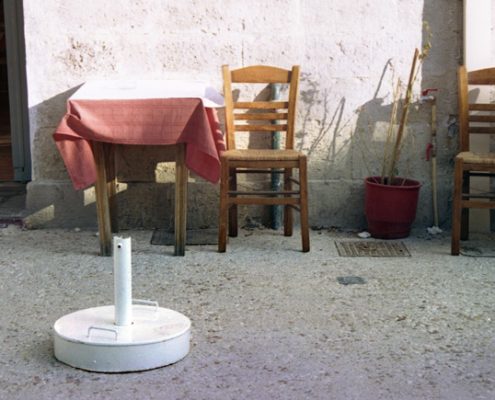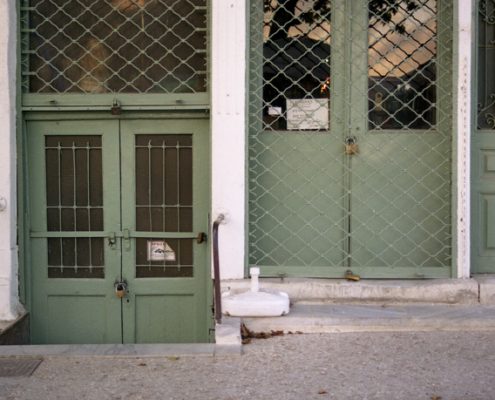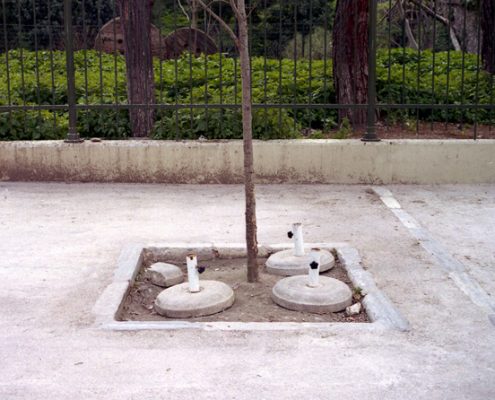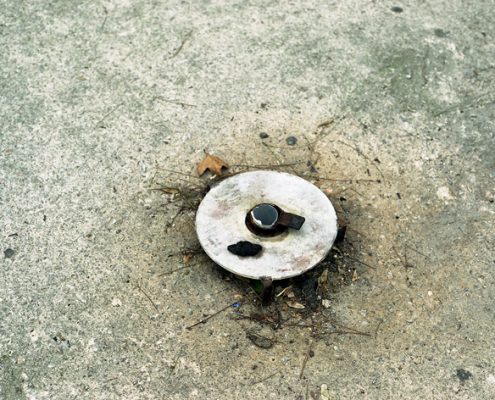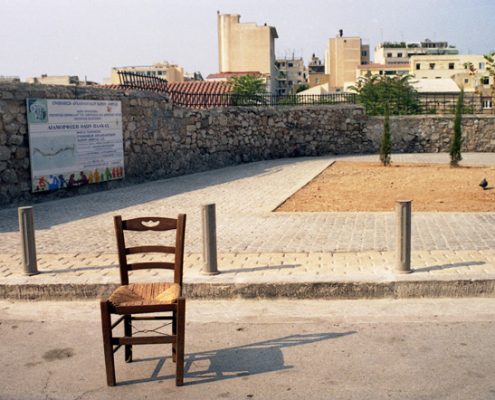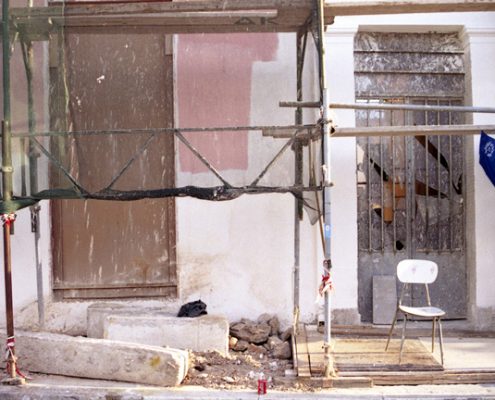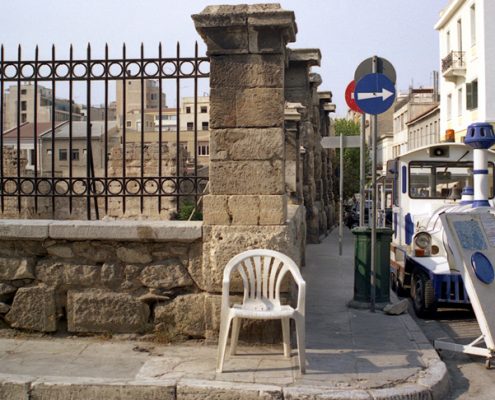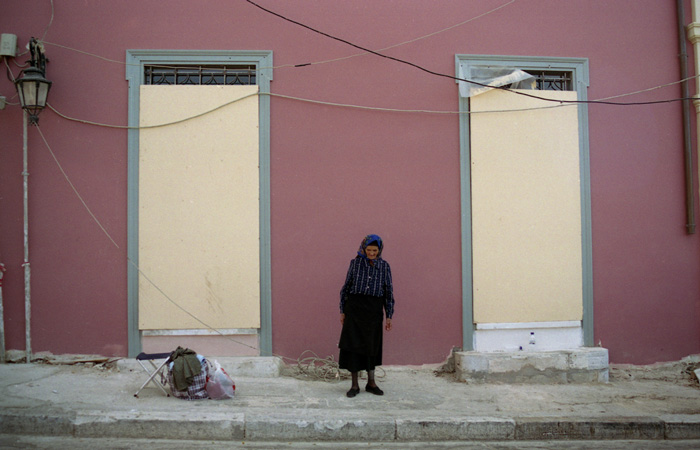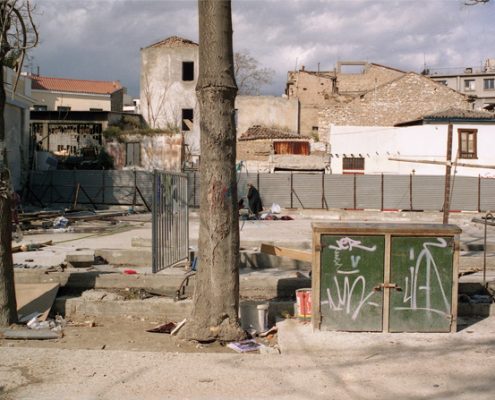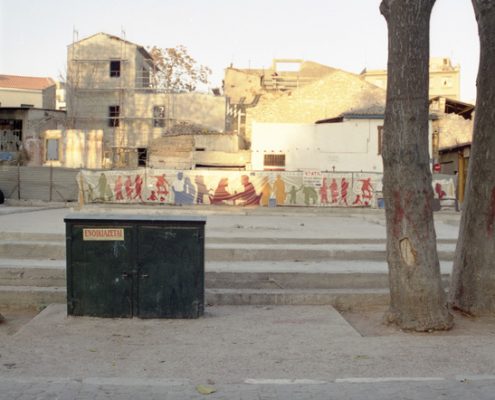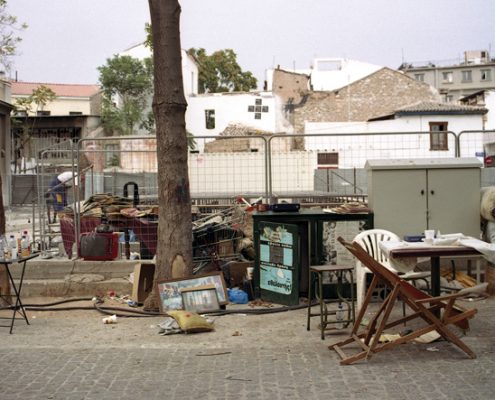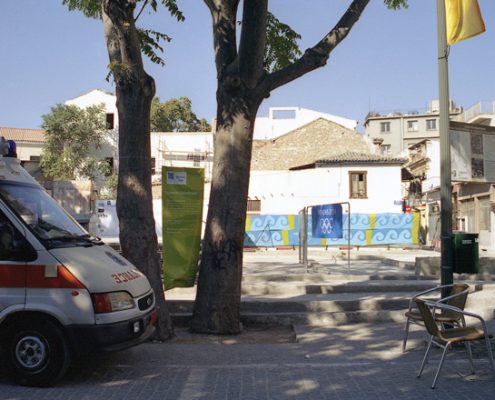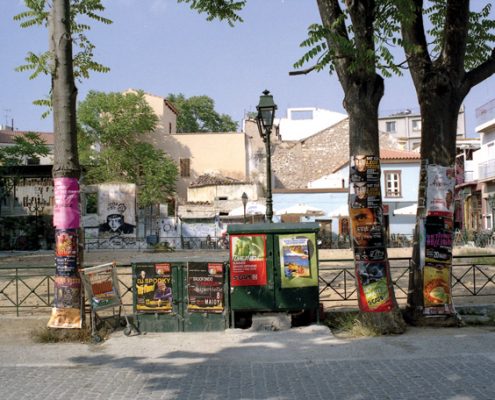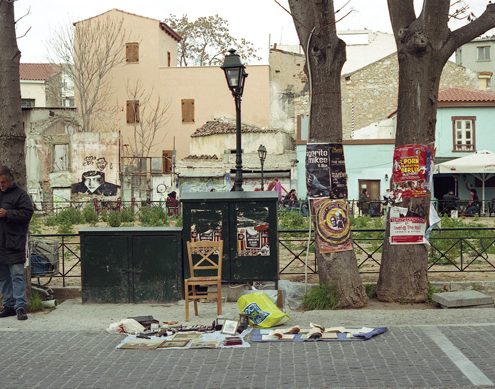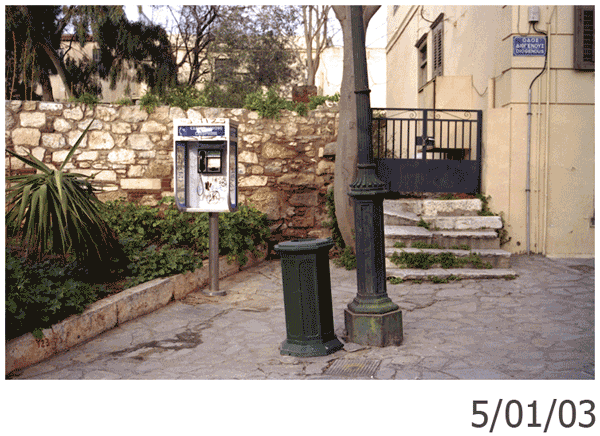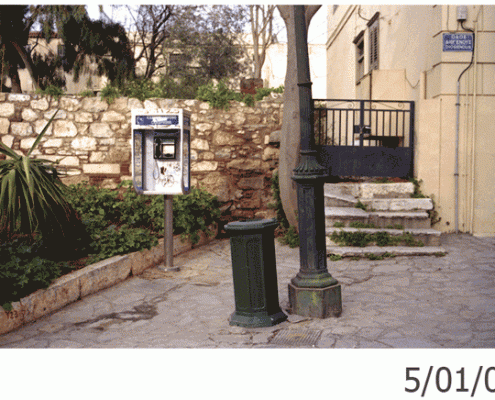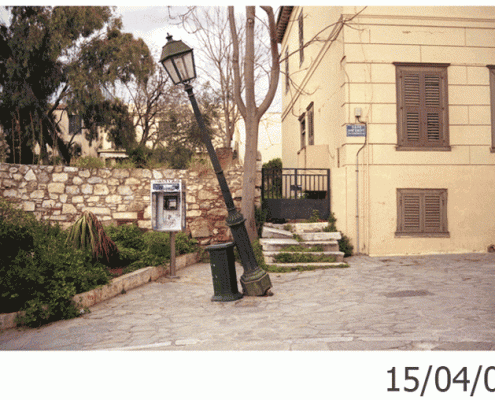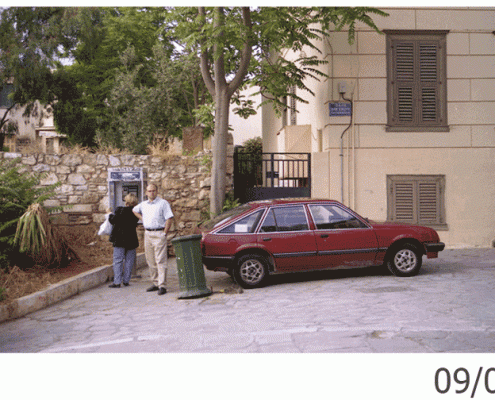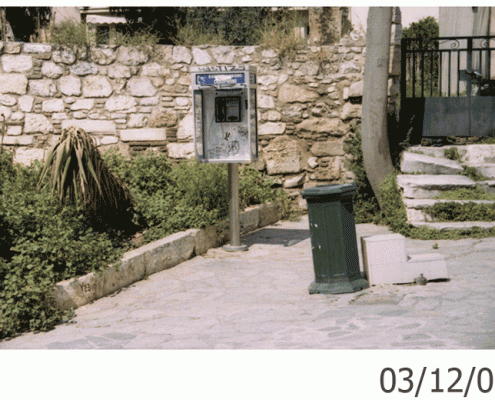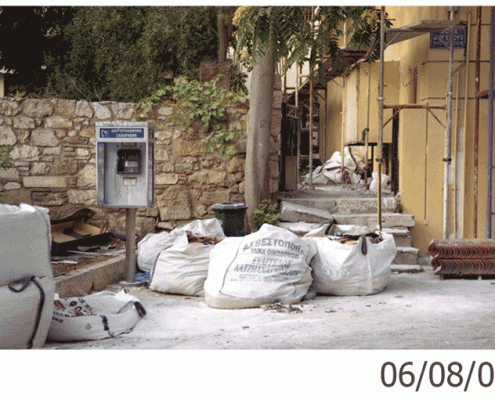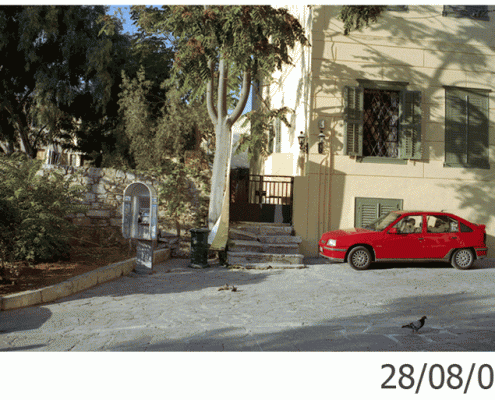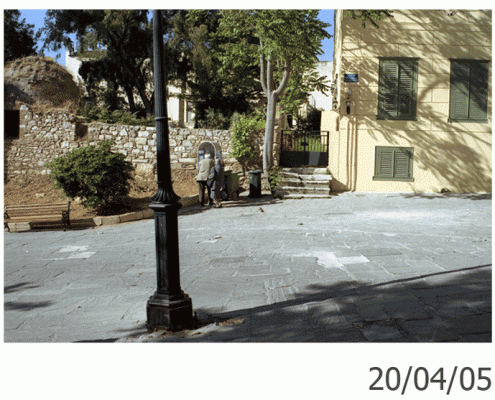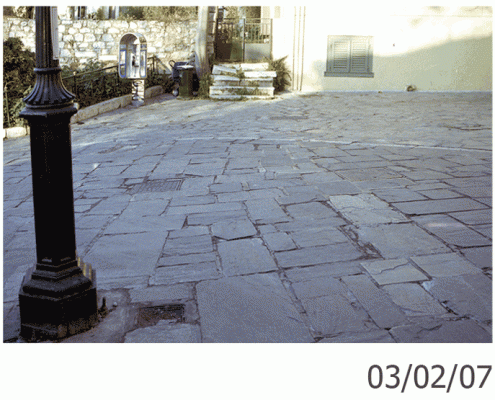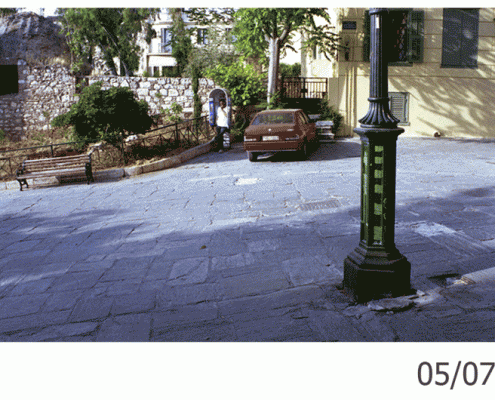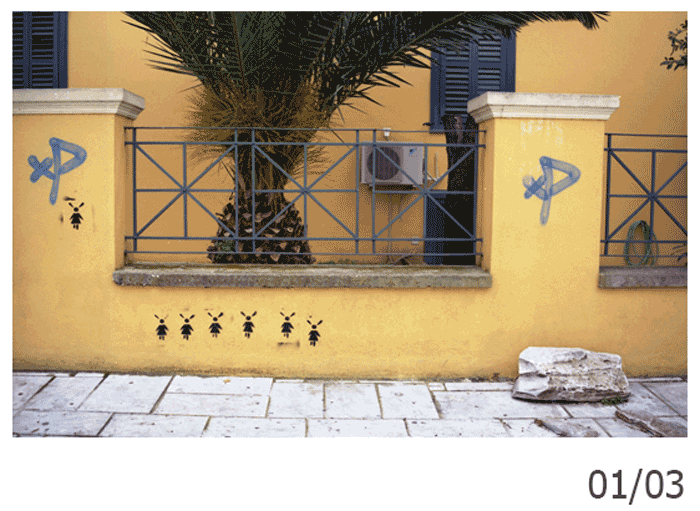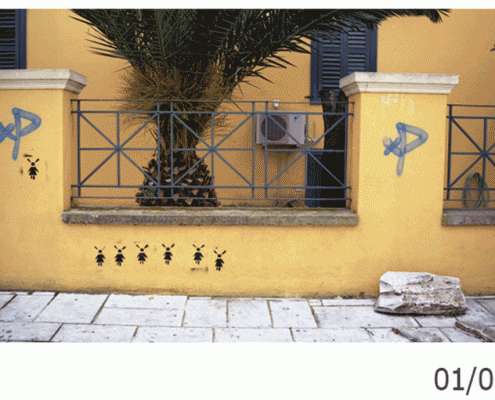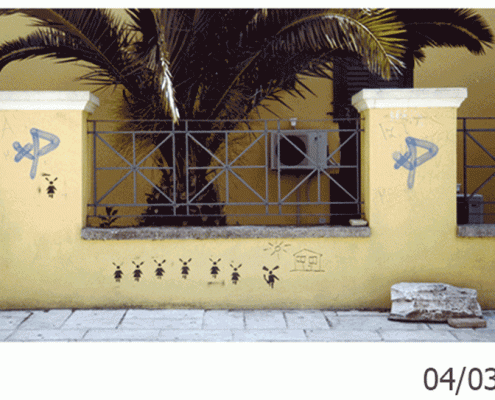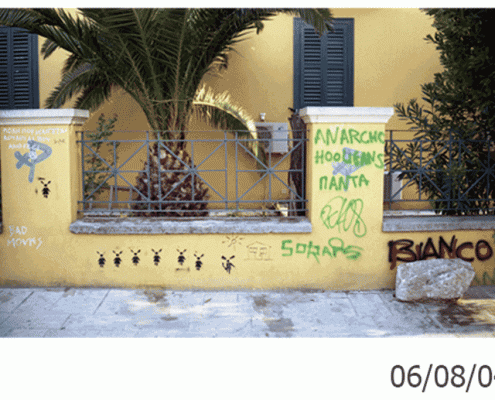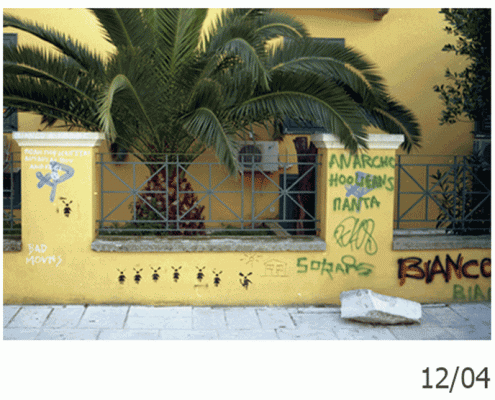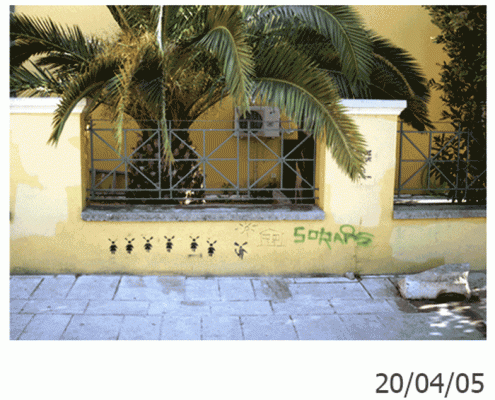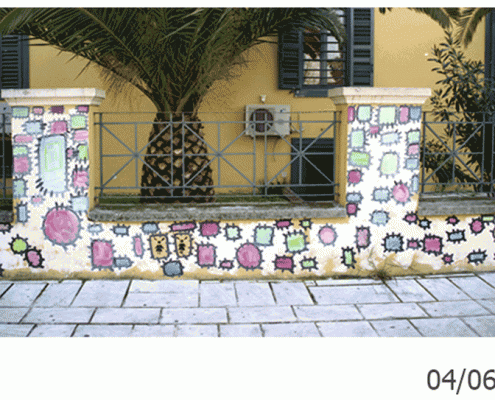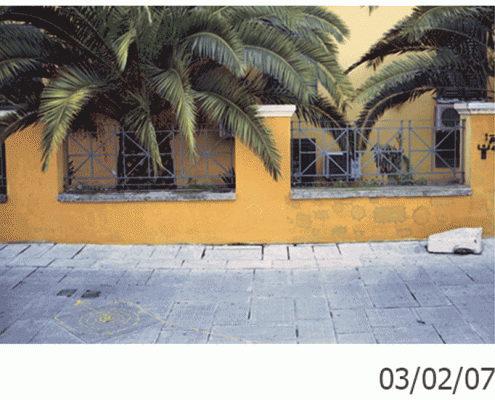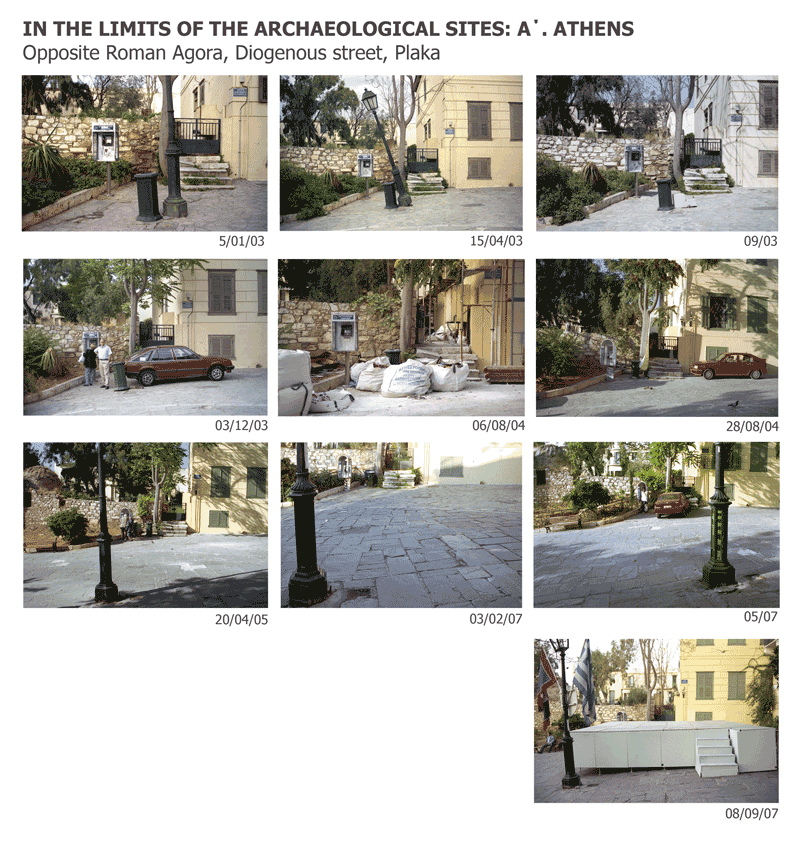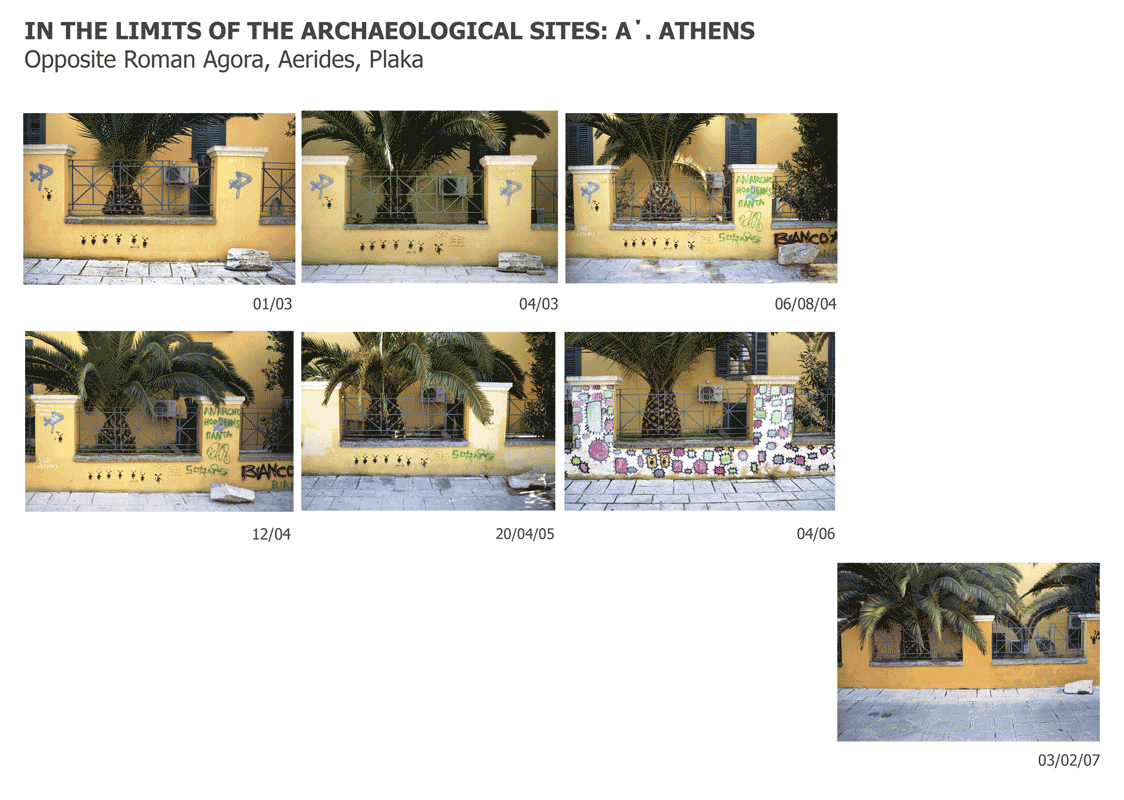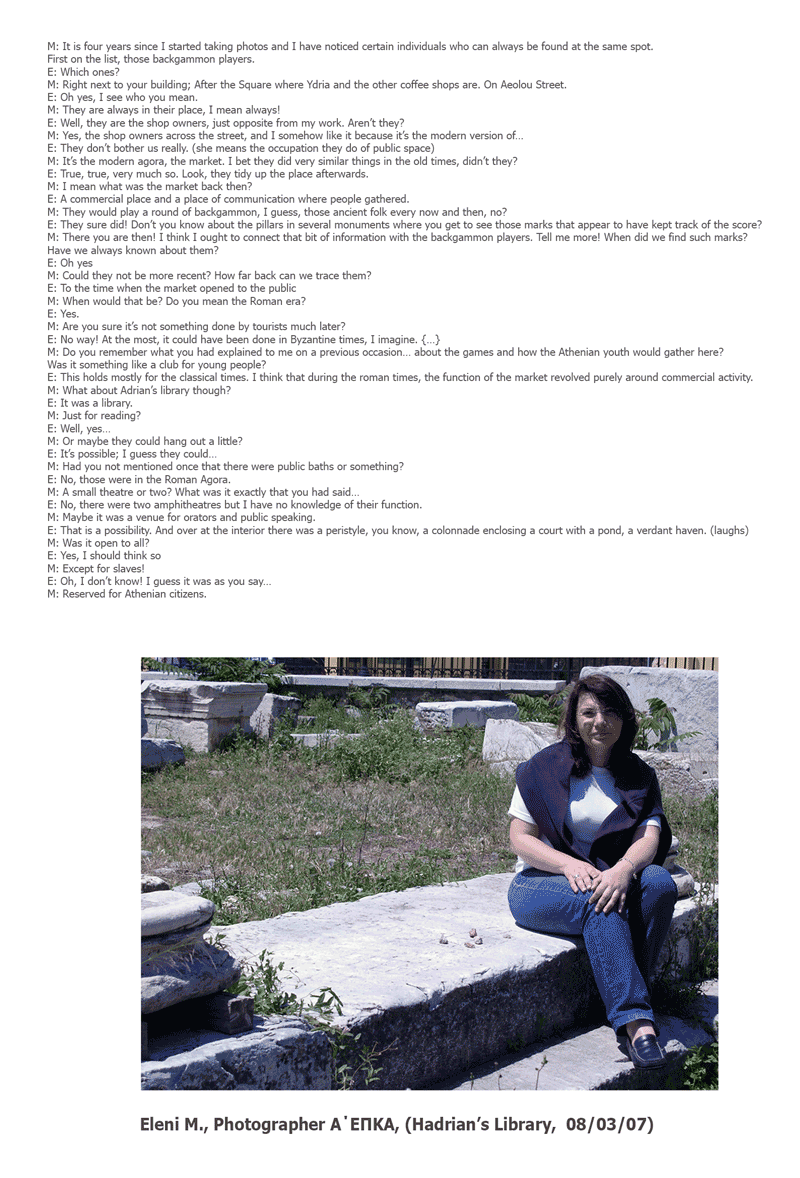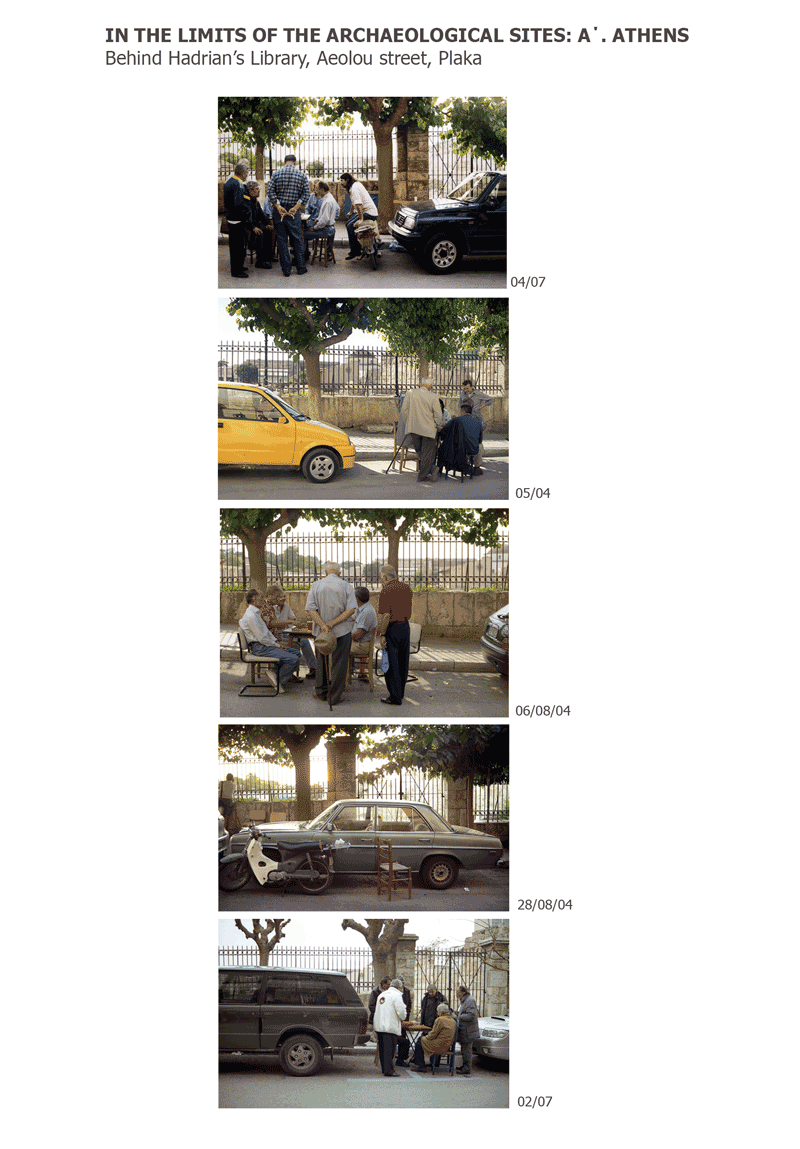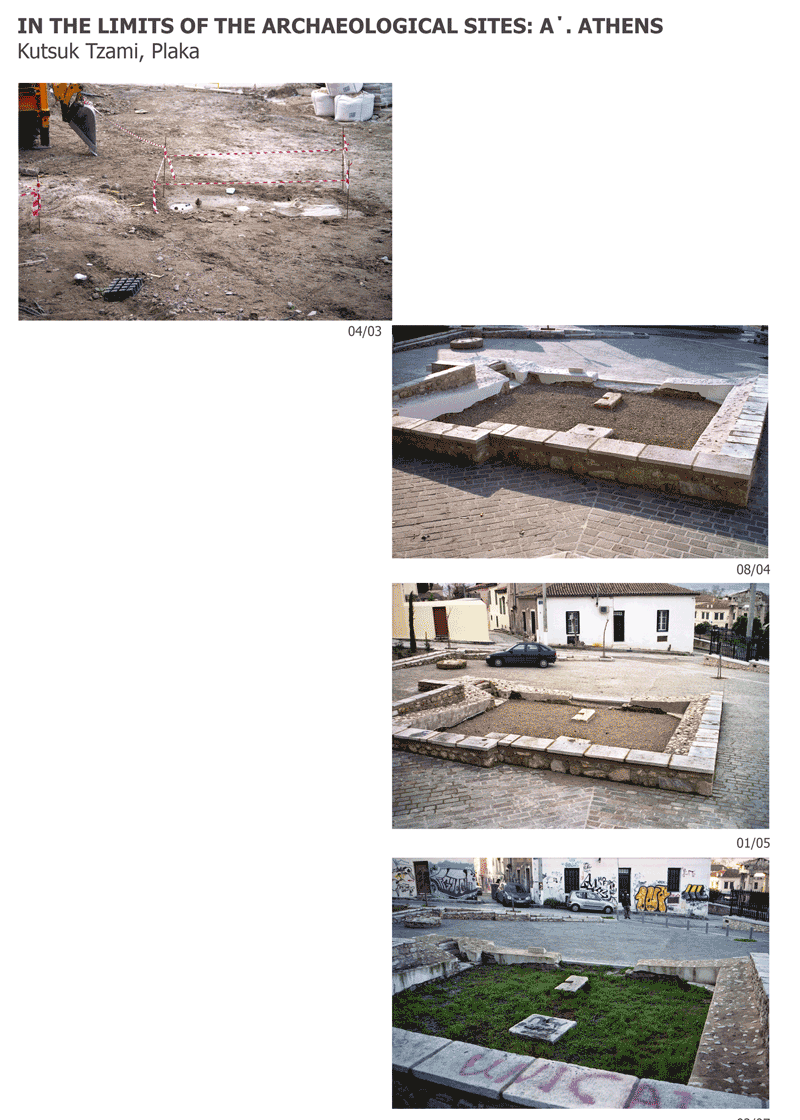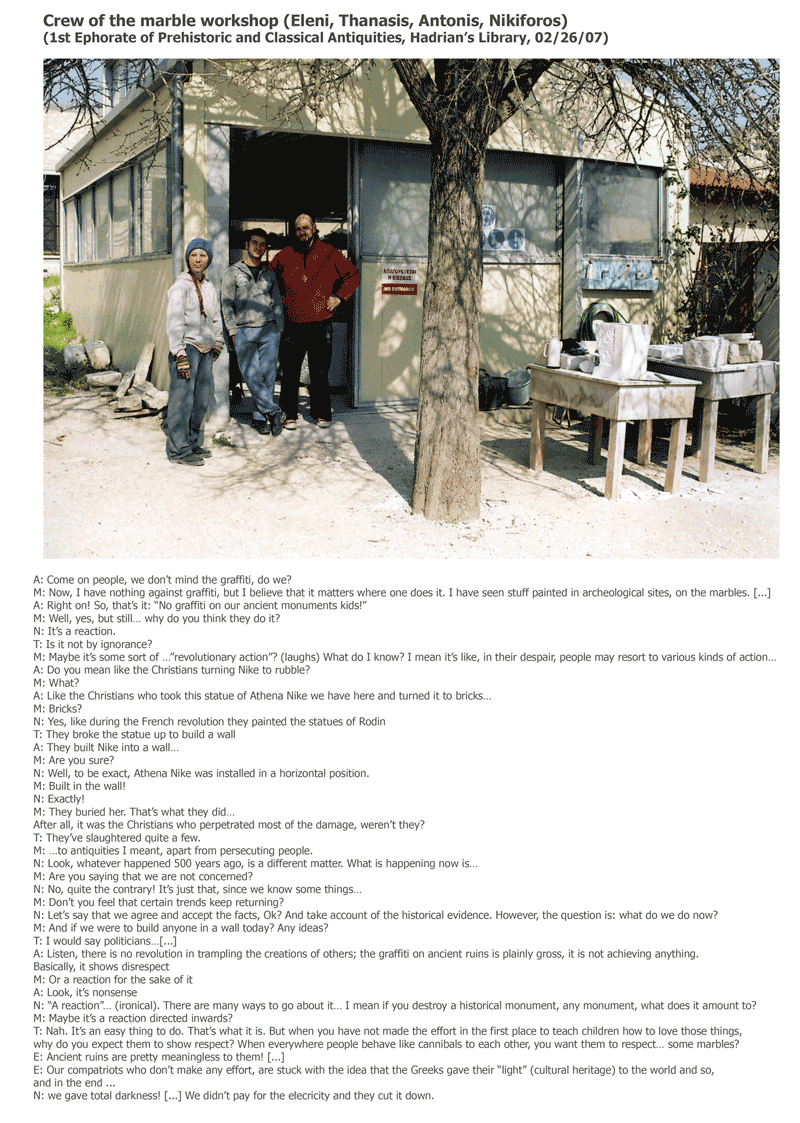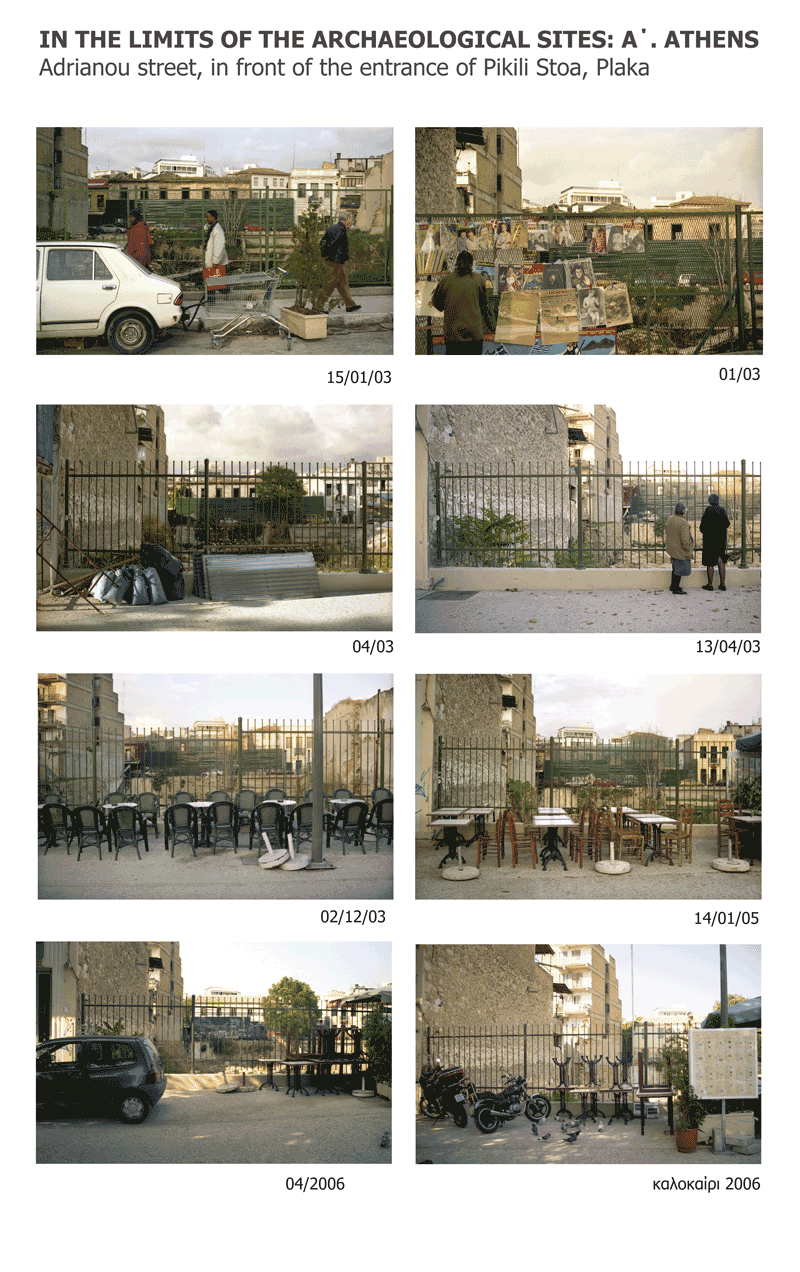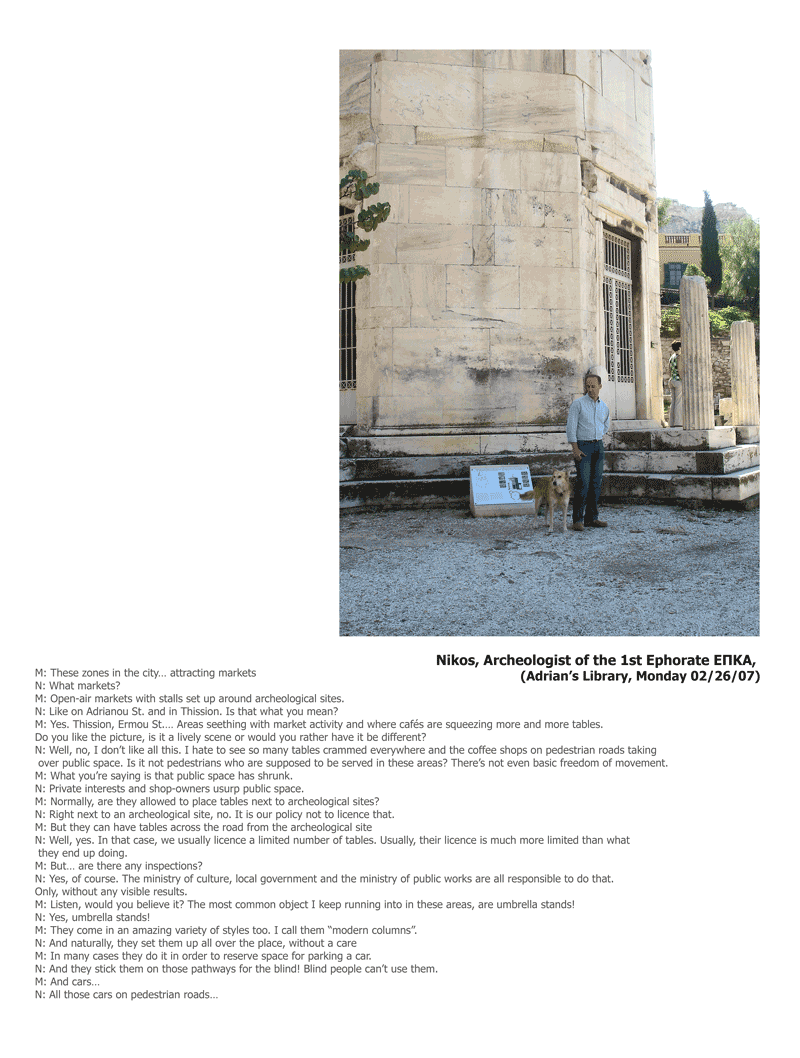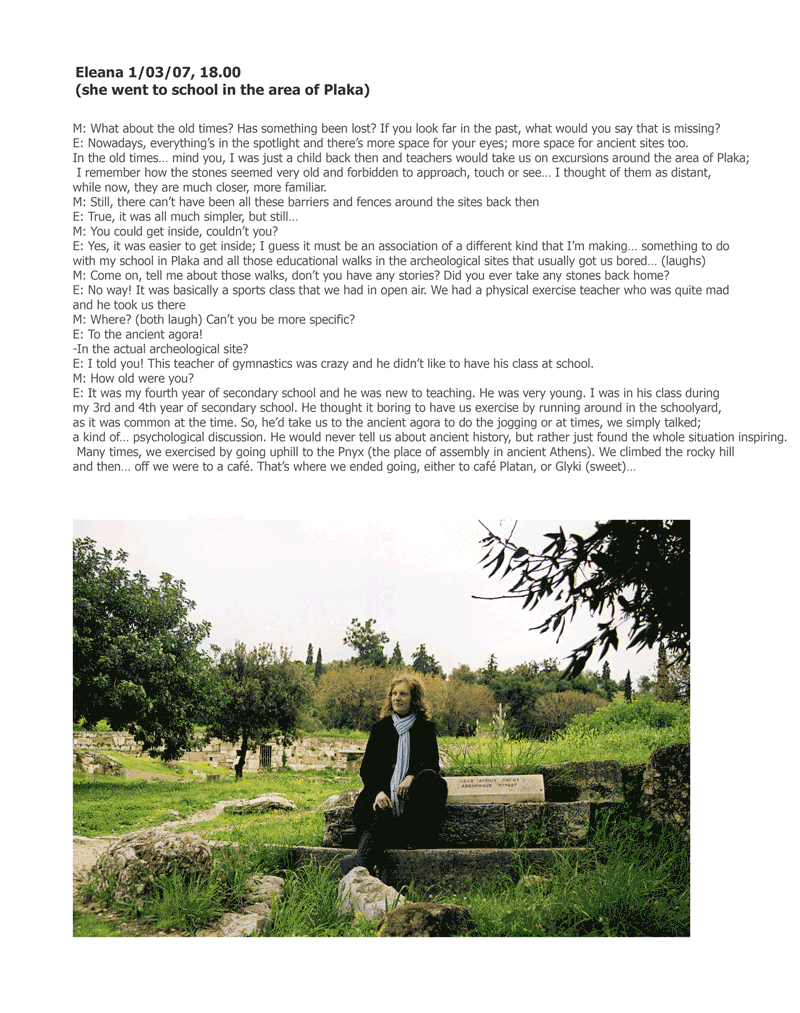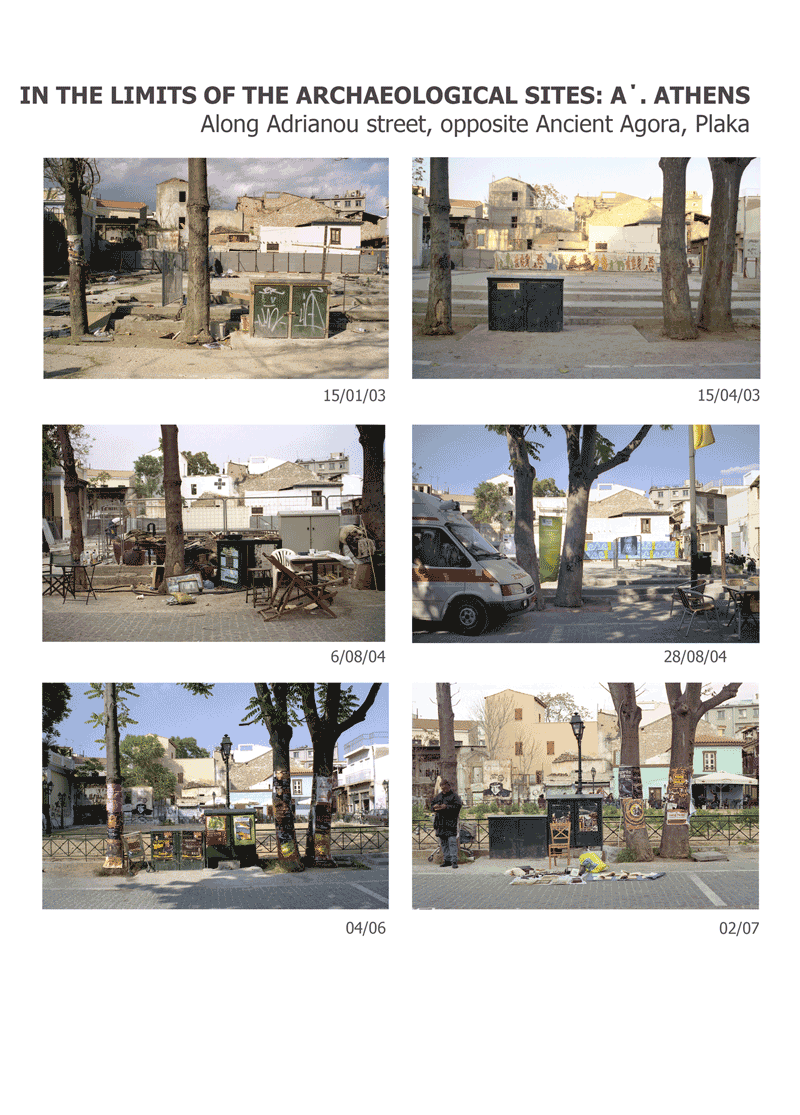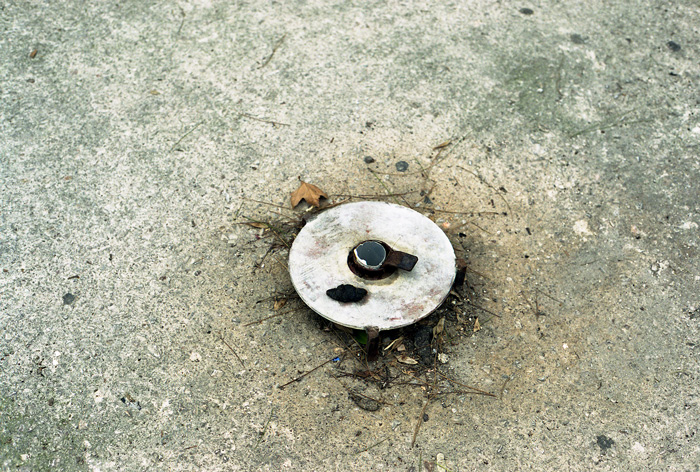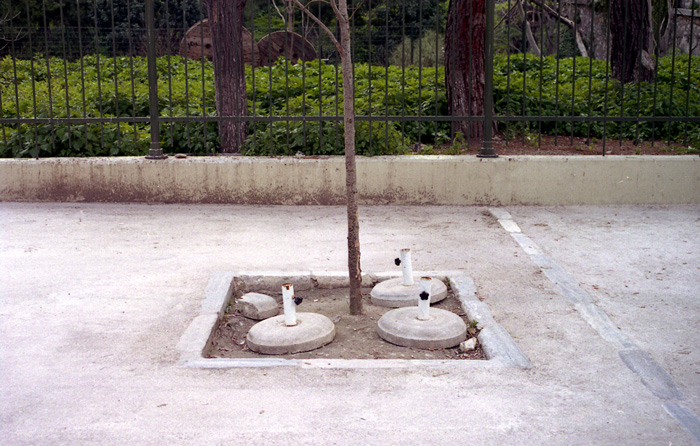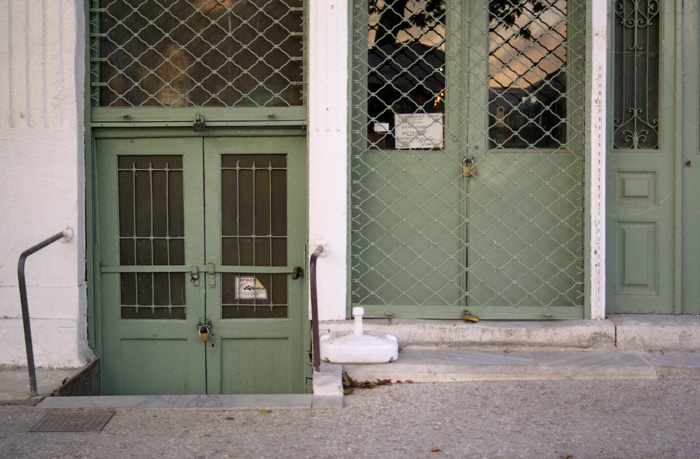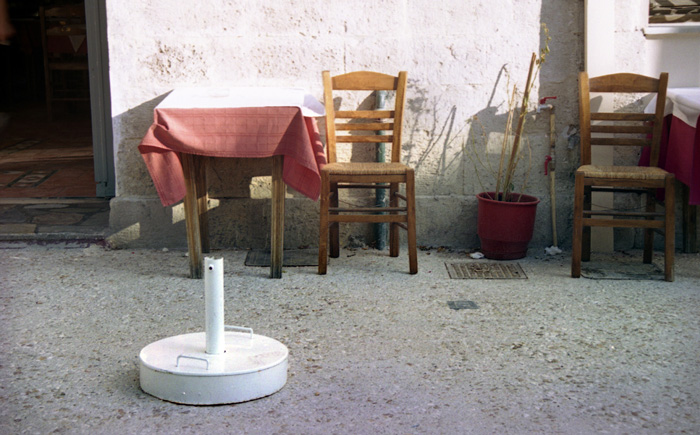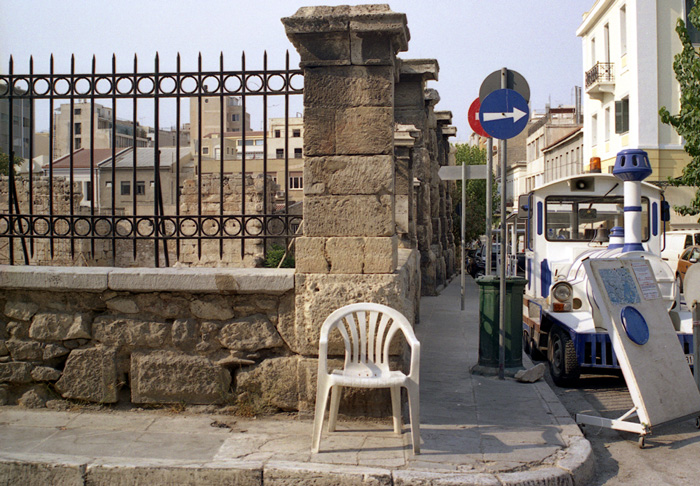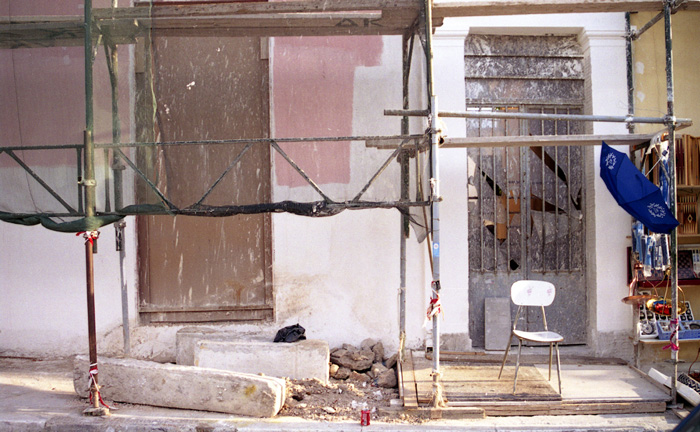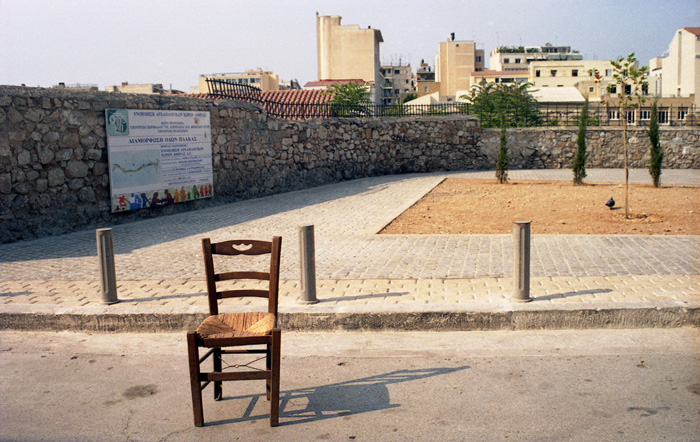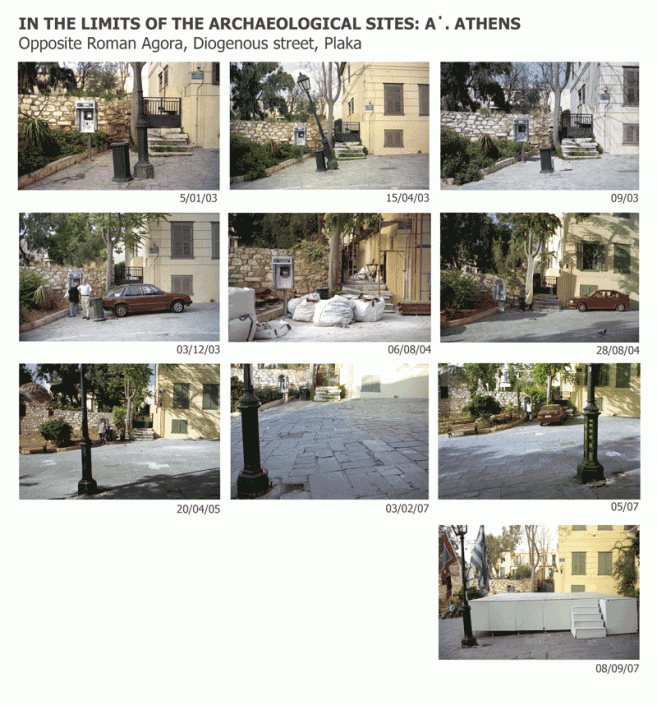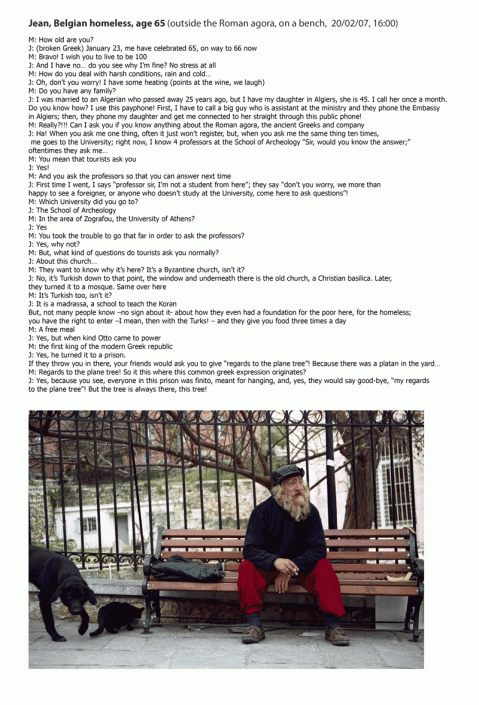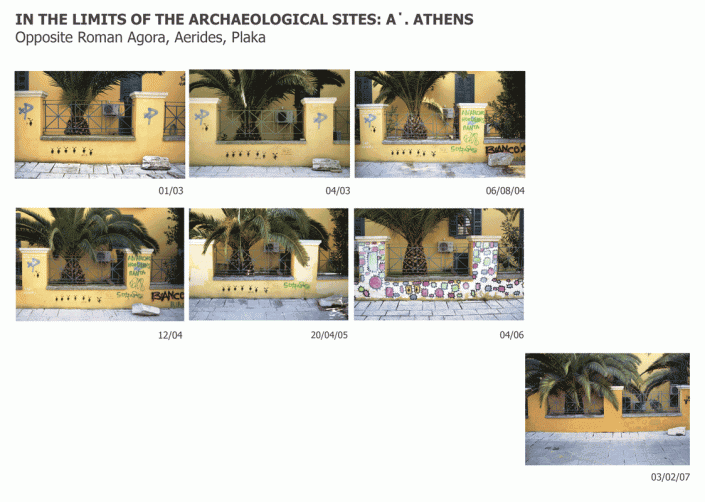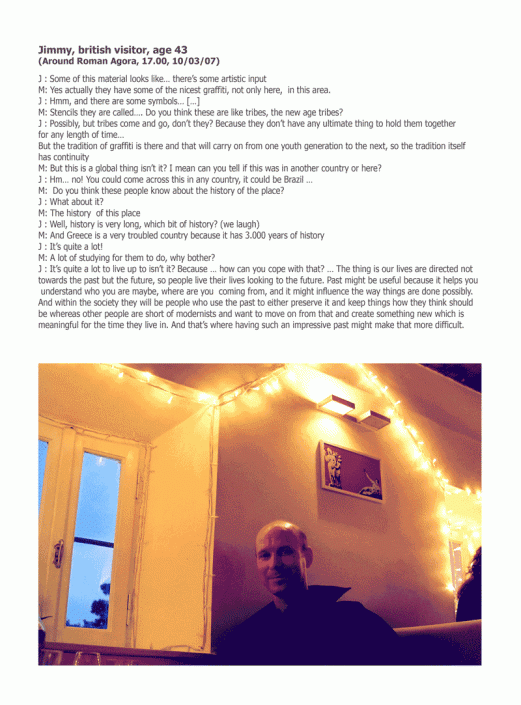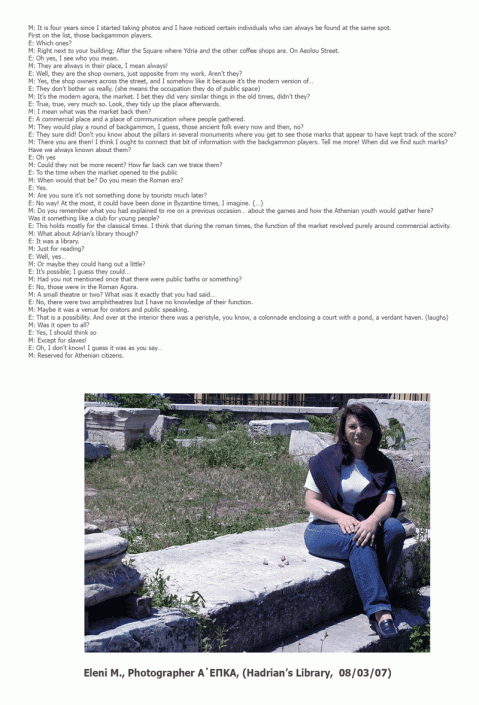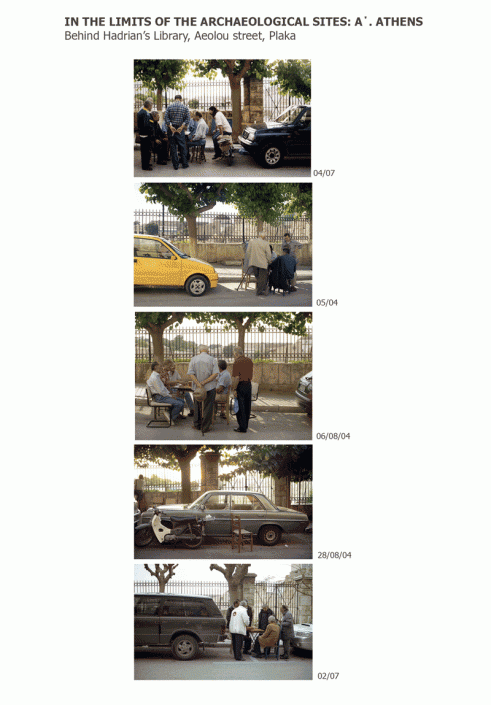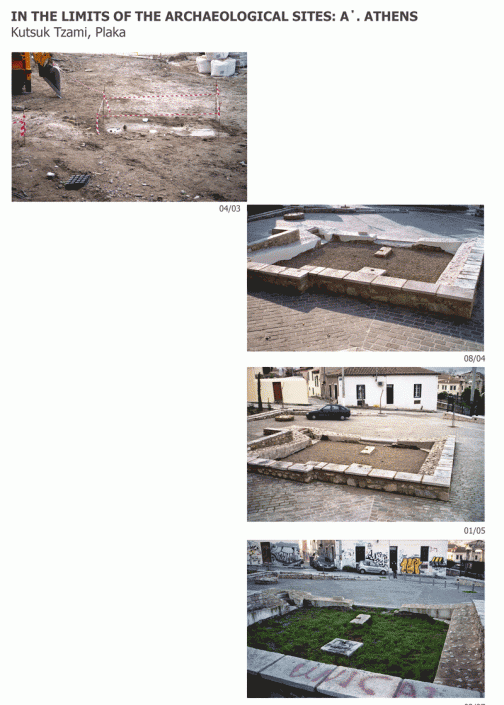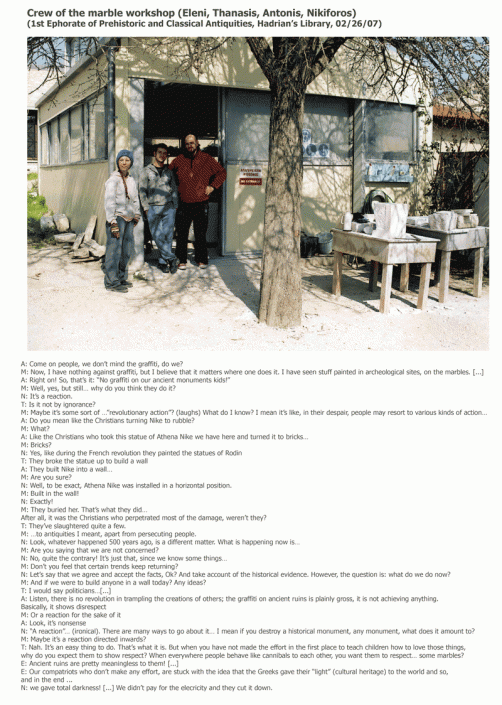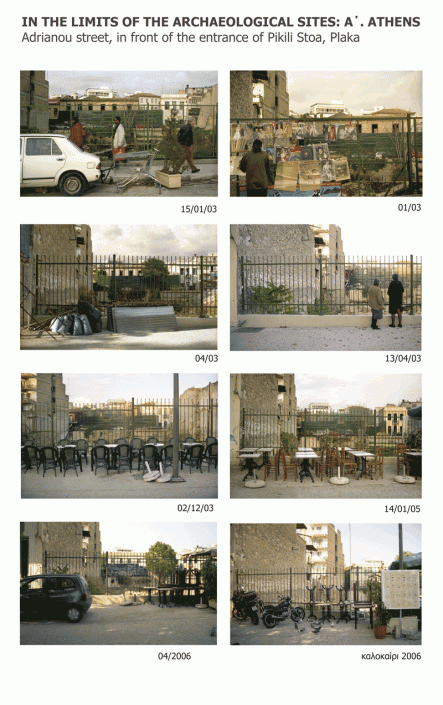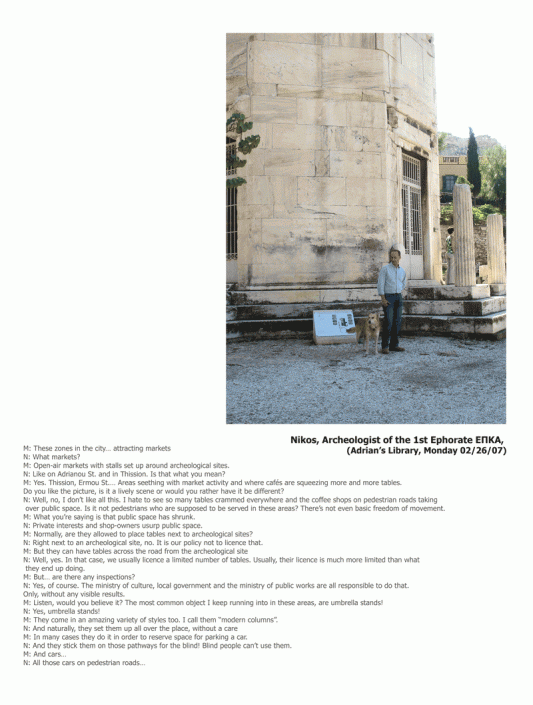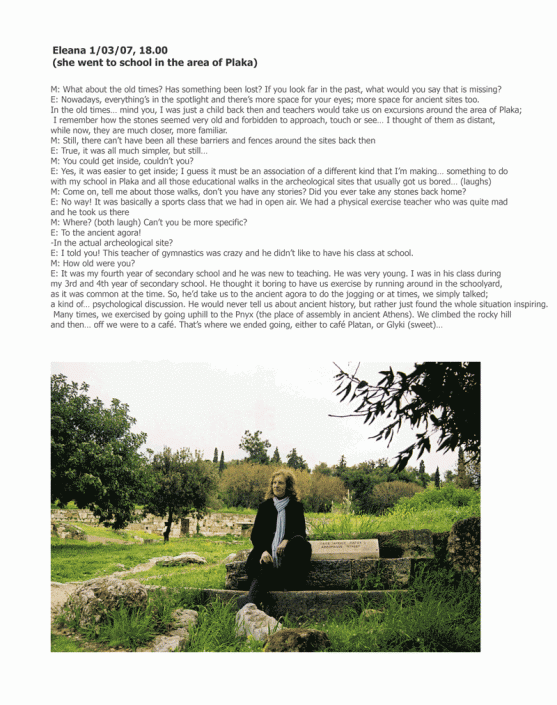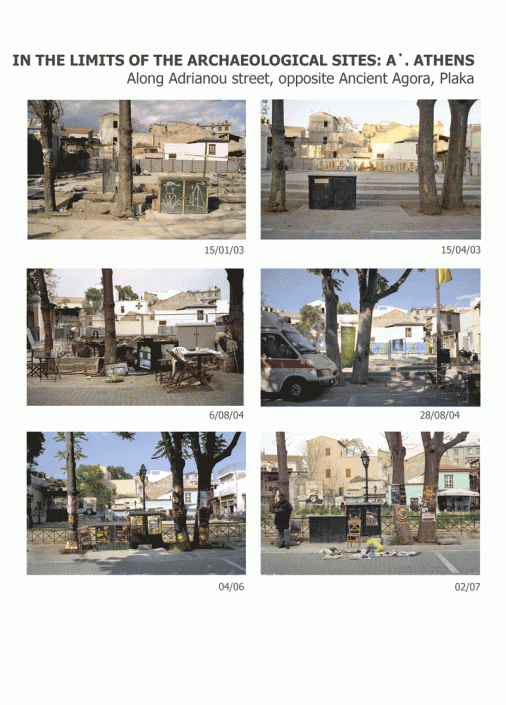À la recherche des situations charnières: en marge des sites archéologiques d’Athènes
Kaminari Melinna
Culture, Histoire
2017 | Déc
Le projet intitulé « À la recherche des situations charnières: en marge des sites archéologiques d’Athènes », se caractérise par le recours à des méthodes ethnographiques (observation participante, entretiens, utilisation de documents d’archives) en même temps qu’à la photographie créative artistique ? en vue de produire une œuvre artistique. Bien que la photographie créative artistique ? ne soit pas en elle-même une méthode scientifique, elle peut fournir une contribution unique sitôt qu’elle s’articule à des méthodes ethnographiques interdisciplinaires, puisqu‘elle aboutit à des résultats chargés d’une expérience vivante, vecteurs de formes impalpables de connaissance. Au cœur de cette démarche se trouvent les «marges» spatiales situées entre les temporalités différentes de l’archéologique et du contemporain, entre les espaces délimités et exploités par la recherche archéologique et leurs abords peu valorisés, au sein de la ville d’Athènes. À travers un certain nombre d’études de cas et en ayant recours à la photographie et à des méthodes ethnographiques, nous interrogeons la manière dont ces lignes « frontalières », ces champs d’analyse, se définissent et se redéfinissent en permanence. En immortalisant à intervalles déterminés, et sur une période de cinq ans, les traces de leur culture matérielle, et en retranscrivant une série d’entretiens réalisés auprès d’individus ayant par moments «habité» ces espaces, on voit apparaître une géographie humaine fugace propre à une situation « charnière » d’interface? Les micro-paysages que nous avons photographiés, coupés de leur environnement si lourdement chargé en signification, racontent des histoires révélatrices de comportements, de tactiques et par là même d’éléments de la culture contemporaine. Parmi celles-ci, bien des signes annonciateurs de la « crise » à venir. Pour autant, ces témoignages n’ont pas valeur de «documentation» au sens traditionnel du terme. En fait, c’est une troisième dimension faite de nombreuses « visualités construites » et de représentations mentales de l’expérience vécue qui se déploie ici, en lien direct avec son créateur. Un résultat nouveau – combinant la parole et l’image – apparaît, qui n’avait pas été remarqué ou que nous n’avions pas su saisir jusqu’à présent
En marge des sites archéologiques
En cherchant le point d’observation le plus approprié pour cette enquête de terrain athénienne, je me suis beaucoup déplacée de part et d’autre de ces marges. Le point d’observation le plus approprié ne pouvait se trouver au beau milieu de ces ruines si précieuses, glorieuses et sacralisées, ni au sein de la ville moderne elle-même. Il se trouvait certainement quelque part au-delà de la « nostalgie esthétisée du lieu commun », [concept introduit par l’architecte Peter Eisenman (1988)] : à la lisière des sites archéologiques et de la ville moderne.
En ces lieux où coexistent la ville antique et la ville moderne, la vie quotidienne et les activités humaines contrastent avec l’atmosphère de calme institutionnalisé des sites archéologiques ouverts au public qui fonctionnent comme des attractions touristiques. L’intérêt des déambulations dans ces marges est que même sans le vouloir, elles interdisent presque au regard de se dérober aux contradictions culturelles et idéologiques. La synthèse des éléments d’altérité dans ces zones peut nous aider à explorer notre identité en perpétuelle évolution, et nous permettre enfin de dégager une vision d’ensemble. S’il s’agit d’interroger le caractère hybride de l’identité dans son état présent, la question cruciale n’est pas « qui suis-je ?» mais « où – quand – comment suis-je ? », comme l’a pertinemment remarqué l’ethnographe Trinh T. Minh-ha (1992). Il est par conséquent dénué de sens de s’autodéterminer en déclarant simplement qui nous sommes ; il convient au contraire de déterminer le « où – quand – comment » nous sommes.
En me mettant en recherche de ce « où – quand – comment suis-je », j’ai commencé à prendre des photographies à intervalles réguliers, en suivant un parcours bien précis le long des marges symboliques et physiques de quelques sites archéologiques du centre d’Athènes. Les photographies jouent le rôle d’archives mémorielles de mes changements et de mes découvertes. J’ai ressenti un vif intérêt à examiner visuellement la manière dont ces sites ont été strictement réservés aux visiteurs, et ce qui se passe dans l’espace public – la plupart du temps des voies piétonnes – qui les entoure.
Figure 1: Pieds de parasols, ces colonnes modernes
Figure 2: La ville des chaises solitaires
Figure 3: Qui sont les gardiens de la ville moderne ? Cette femme se trouve en permanence devant la Bibliothèque d’Hadrien.
Ces premières découvertes n’étaient toutefois pas suffisantes. J’ai poursuivi mon travail photographique durant six ans, à périodes fixes, en me concentrant plus particulièrement sur une sorte de micro-ethnographie visuelle. Si « l’ethnographie est l’étude du savoir culturel, aussi bien dans sa forme explicite et formelle, que tacite et silencieuse, sous-jacente » – comme le dit James Spradley (1980:8) –, j’ai été au cours de cette enquête à la recherche des deux formes. Le savoir culturel sensible et formel m’a servi de matière première, de point de départ théorique. Le savoir silencieux et sous-jacent, qui demeure pour une large part extérieur à la perception humaine, ne s’exprime pas consciemment et ne fait pas l’objet d’un débat, était mon objet d’étude. Une fois ce savoir silencieux véritablement ressenti, mon regard a pu se forger comme celui d’un observateur tantôt intérieur, tantôt extérieur.
Figure 4: Le long de la rue Adrianou, face à l’entrée principale de l’ancienne agora, Plaka, Athènes
|
Que signifie exactement le fait qu’une ville est en train d’évoluer ? En plaçant les photographies côte-à-côte, j’ai réalisé que certaines « histoires » ou récits se déroulaient d’une façon beaucoup plus conforme à mon esthétique, bien plus efficace du point de vue de ce que je voulais montrer. J’ai commencé à distinguer à travers les photographies des changements que je n’avais pas pu voir à l’œil nu lorsque que je me trouvais sur place pour réaliser les photos.
Figure 5: Les aventures d’un réverbère
|
Figure 6: Bâtiment néoclassique face à la Tour des Vents de l’agora romaine
Il s’git d’une une maison située face au site archéologique de l’Agora Romaine à côté de la tour de « Aerides ».
|
Les photographies sont coupées de leur cadre analytique général et de leur environnement visuel (antiquité, archéologie, grandeur du passé, patrimoine culturel etc.). Elles tentent d’atteindre leur «lecteurs» au moyen d’une représentation symbolique de la réalité de l’Autre (dans ce contexte, l’Autre est la mentalité des Grecs contemporains). Au fil du temps, des thématiques ont commencé à apparaître, ce qui m’a permis d’entamer la phase des entretiens. Vingt-cinq entretiens avec des individus venant régulièrement habiter ces lieux, une fugace géographie humaine des marges ou zones frontalières qui se laisse momentanément observer.
Pour autant, l’objet de mon enquête n’était pas d’apporter des réponses à des questions… « Que pensez-vous des travaux visant à relier les sites archéologiques entre eux ? », « qu’est-ce qui peut bien rassembler ici des gens à ce point hétéroclites ? », « quel est votre avis concernant les tables et les sièges occupant l’espace public et les trottoirs ? », « que ressentez-vous devant les graffiti qui couvrent ou entourent les sites archéologiques ? », « pourquoi autant de drogue dans ces zones ? », « quelle est la place de l’État dans tout cela ? », et enfin « pensez vous que les Grecs contemporains ont quoi que ce soit de commun avec les Grecs anciens ? »…La véritable découverte, en ce qui me concerne, a résidé dans le contenu des « confessions » de ces gens. Les images des personnes interviewées ont ensuite été repositionnées dans les lieux auxquels elles appartenaient. Lieux qui leur avaient été par moi attribués – sans qu’ils ne le sachent – alors qu’ils me racontaient leurs histoires.
La découverte du fait qu’une simple cabine téléphonique que je passais mon temps à photographier pouvait jouer un rôle aussi important dans la vie d’un individu était une chose qui dépassait totalement mon imagination. Un clochard belge de soixante-cinq ans prenait le bus pour se rendre dans une université très éloignée du centre-ville, uniquement pour se rendre utile et serviable auprès des touristes. L’ensemble de mes stéréotypes concernant les clochards, ces personnages « marginaux », se sont effondrés.
Les entretiens ont donné de la vie aux photographies grâce aux récits subjectifs qu’ils véhiculent, récits parfois dominants, parfois marginaux. Tentative de constitution d’un inventaire de quelques réalités ethnographiques, qui s’enrichit en permanence sans jamais s’achever. Avec pour résultat le fait que les histoires individuelles se mêlent à l’histoire collective. Le récit d’un individu peut constituer le palimpseste des histoires et opinions de nombreuses autres personnes du quotidien, permettant ce que Stuart Hill évoque comme la création « d’une langue visuelle particulière, enracinée dans la réalité de l’expérience vécue et qui dans le même temps constitue la plus harmonieuse articulation de cette expérience » (Hall 1983:17 in Edwards 1999, 74).
En déclenchant cet événement, on obtient une juxtaposition (une parataxe) de temporalités divergentes apparaissant toutes sur la même photographie. Le résultat visuel final rend compte d’une histoire différente et plus complète que celle qu’exprime séparément chacune des photographies ou des entretiens. Une visualité construite, une représentation mentale à laquelle nous n’avions jamais été confrontés. Il s’agit d’une tentative de représentation non pas d’un lieu, mais des expériences vécues d’un lieu. Ce qui se passe à l’extérieur des sites archéologiques se trouve inévitablement en dialogue constant avec l’ « institutionnalisé », l’interdit, ce qui dans le savoir et le patrimoine historique officiel est souvent hermétiquement fermé.
| “Une collection photographique nous livre l’histoire du photographe », dit l’artiste et écrivain Desiree Navab (2009), « mais celle-ci n’est qu’une des histoires. Il y a aussi les histoires des personnes représentées et des événements contenus dans la photographie, ainsi que les histoires des spectateurs de la photographie, qui sont à l’extérieur. Ensuite il y a l’histoire qui se construit autour de toutes ces histoires. Des histoires privées et inconnues nous tirons des histoires publiques et bien connues. Des mémoires et histoires isolées, émerge une mémoire et une histoire collective ». |
Suite à cette intervention optico-ethnographique, les choses cessent d’être ce qu’elles étaient, au moins pour ceux qui ont partagé l’expérience de cette intervention. Voici comment la photographie peut devenir un dispositif transmettant l’inédit, le savoir silencieux-implicite, le savoir sous-jacent, et le traduire en ce que W.J.T. Mitchell (2007) décrit comme « ce qui ressemble à la photographie d’une chose que nous n’avions jamais pu voir auparavant », ou ce que Victor Burgin (1996:272) décrit comme « une expérience culturelle » traduisant l’inconscient en conscient.
D’autre part, ce travail vise à identifier une lueur dans un monde obscur : des éléments d’espoir et de résistance au milieu de tout ce qui nous désenchante dans cette ville. La confrontation avec l’image moderniste et idéalisée de notre passé et la découverte alternative, presque insolente du précieux paysage historique pourrait constituer l’outil thérapeutique suggéré par Edgar Morin (Le Goff, 1998).
Un outil d’adaptation au changement, un outil permettant d’entrer dans une réalité présente qui offre la perspective d’un avenir. Il est commun d’entendre les gens présenter la situation actuelle comme problématique, comme critique, décadente. Sur les photographies, comme dans les récits que nous avons collectés, cette destruction, ce vide, cette désarticulation sont souvent représentés, non pas comme quelque chose de condamnable ou de répréhensible, mais comme une étape créatrice, en ce qu’elle indique des changements sous-jacents. Elle est représentée comme une série de symboles et d’indices faisant écho à la façon dont nous vivons profondément en nous-même la situation sociale, culturelle, politique et économique. Le « nous avons touché le fond » peut se transformer en instrument de remontée vers la surface, l’occasion de développer un savoir sur ce qui dysfonctionnait, et sur comment nous pourrons résoudre ce dysfonctionnement, comme une sorte de thérapie des erreurs que nous ne cessons de réitérer. C’est en franchissant la barrière imaginaire entre le passé primitif et le lieu d’origine actuel, loin de la « polarisation de modèles contradictoires » propres au monde intellectuel, que l’on peut acquérir ce si précieux ressenti. Et en effet, l’intimité avec les gens a fait souffler une « brise d’authenticité » qui a rendu les pénibles vérités plus supportables.
Les histoires quotidiennes des gens, et celles qui se déroulent parallèlement, les histoires apparemment insignifiantes du monde matériel entourant les sites historiques athéniens si lourdement chargés – et c’est sans doute la raison pour laquelle elles passent inaperçues – sont représentées côte-à-côte. Les objets qui sont représentés peuvent être des « pièges » nous menant à donner un nouveau contenu à l’idée stéréotypée que nous avions des sites archéologiques, et ainsi rendre ceux-ci moins «académiques» et plus humains. Quelques unes de ces photographies pourront peut-être provoquer le rire mêlé aux larmes de la tragédie grecque ancienne. Le sentiment de catharsis qui vient lorsque nous sommes finalement confrontés à la « vérité », qui nous fait pleurer et rire en même temps.
«Tracing liminalities» (À la recherche des situations charnières) – Melinna Kaminari, 2003-2009
Six œuvres – faisant partie d’un ensemble plus grand de vingt-cinq œuvres – 70 x 100 cm chacune. Le portrait et l’entretien de chaque personne sont juxtaposés dans le cadre de la nouvelle photographie du micro-paysage situé près du site de l’interview.
Figure 7a: Aux limites des sites archéologiques: A’ Athens. En face de l’agora romaine, rue Diogenous, Plaka
Figure 7b: Jean. Sans-abri belge, âge 65 (devant l’agora romaine, sur un banc, 20/02/07, 16:00)
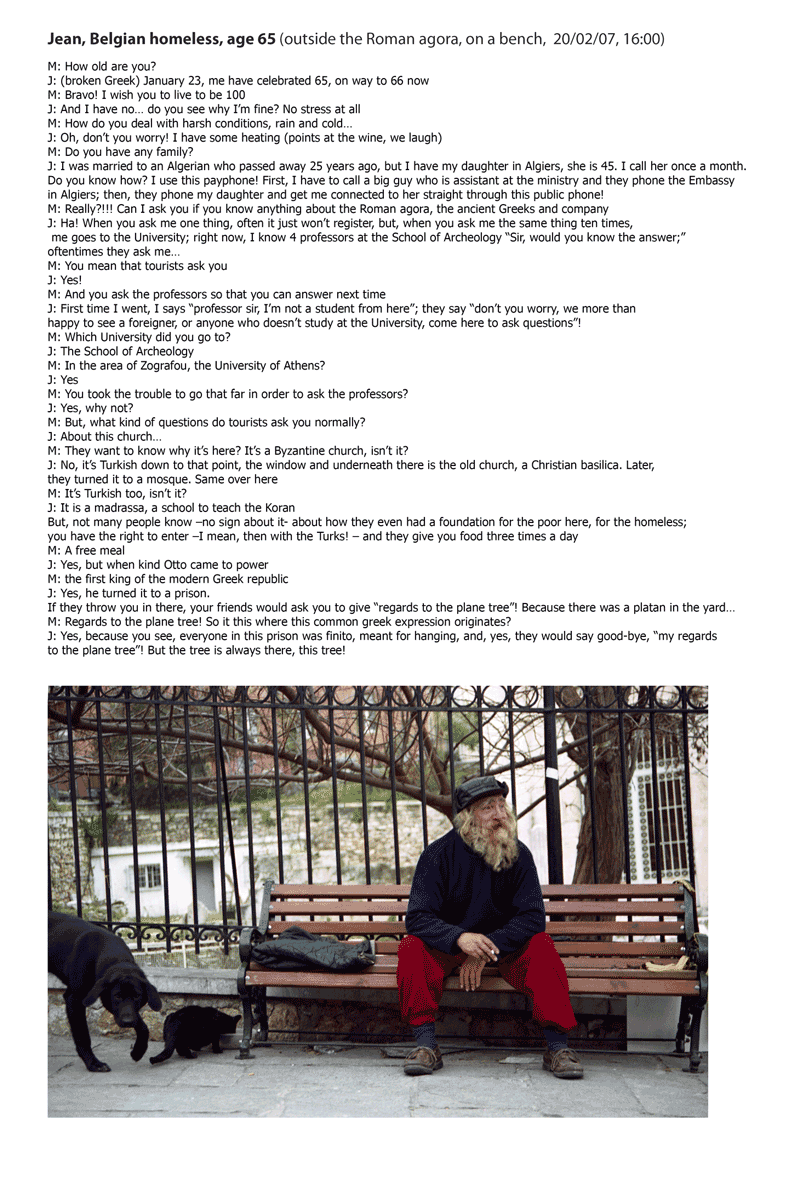 Figure 8a: Aux limites des sites archéologiques: A’ Athens. En face de l’agora romaine, Aerides, Plaka
Figure 8a: Aux limites des sites archéologiques: A’ Athens. En face de l’agora romaine, Aerides, Plaka
Figure 8b: Jimmy, Visiteur britannique, âgé de 43 ans (Autour de l’Agora romaine, 17:00, 10/03/07)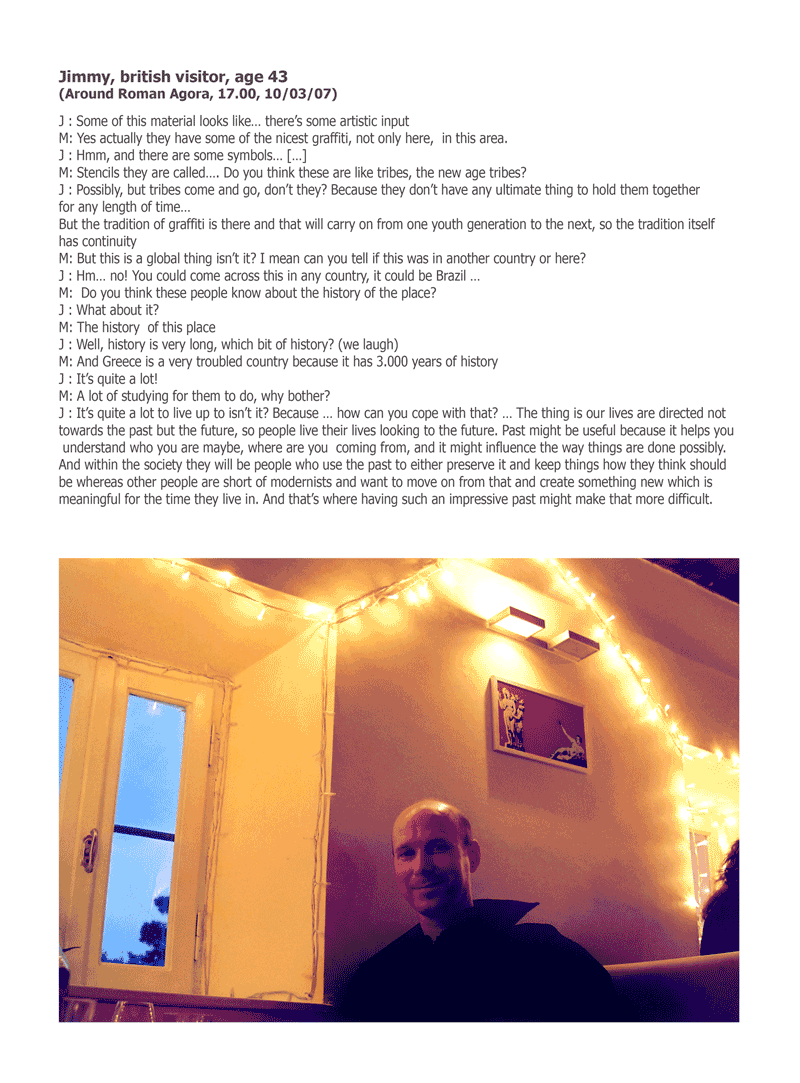 Figure 9a: Eleni M., Photographe A’ EPKA, (Bibliothèque d’Hadrien, 08/03/07)
Figure 9a: Eleni M., Photographe A’ EPKA, (Bibliothèque d’Hadrien, 08/03/07)
Figure 9b: Aux limites des sites archéologiques: A’ Athens. Derrière la bibliothèque d’Hadrien, rue Aeolou, Plaka
Figure 10a: Aux limites des sites archéologiques: A’ Athens. Kutsuk Tzami, Plaka
Figure10b: Equipe de l’atelier de marbre (Eleni, Thanasis, Antonis, Nikiforos), 1er éphorat des antiquités préhistoriques et classiques, bibliothèque d’Hadrien, 02/26/07
Figure 11a: Aux limites des sites archéologiques: A’ Athens. rue Adrianou, devant Pikili Stoa, Plaka
Figure 11b: Nikos, Archéologue du 1er éphorat EPKA, bibliothèque d’Hadrien , Lundi, 2/26/07
Figure 12a: Eleana 1/03/07, 18:00. Elle est allée à l’école dans la région de Plaka
Figure 12b: Aux limites des sites archéologiques: A’ Athens. Le long de la rue Adrianou, ancienne agora, Plaka
Référence de la notice
Kaminari, M. (2017) À la recherche des situations charnières: en marge des sites archéologiques d’Athènes, in Maloutas Th., Spyrellis S. (éds), Atlas Social d’Athènes. Recueil électronique de textes et de matériel d’accompagnement. URL: https://www.athenssocialatlas.gr/fr/article/a-la-recherche-des-situations-charnieres/ , DOI: 10.17902/20971.78
Référence de l’Atlas
Maloutas Th., Spyrellis S. (éd.) (2015) Atlas Social d’Athènes. Recueil électronique de textes et de matériel d’accompagnement. URL: https://www.athenssocialatlas.gr/fr , DOI: 10.17902/20971.9
References
- Le Goff J (1998) Ιστορία και Μνήμη. Κουμπουρλής Γ (επιμ.), Αθήνα: Νεφέλη.
- Burgin V (1996) In/different spaces: Place and memory in visual culture. Berkeley, Los Angeles, London: University of California Press.
- Douglass M (1999) Implicit Meanings: Selected Essays in Anthropology. London: Routledge.
- Eisenman P (1988) The Blue Line Text. Architectural Design, New York 58(Academy Editions).
- Hall S (1983) Interview with Stuart Hall. Camera Work 29: 17–19.
- Mitchell W (2007) There Are No Visual Media. In: Grau O (ed.), MediaArtHistories, Cambridge: The MIT Press, p. 488.
- Spradley JP (1980) Participant observation. New York: Holt, Rinehart and Winston, Wadsworth/Thomson Learning.
- Trinh TM-H (1992) Framer framed. New York: Routledge.
- Νavab AD (2009) She speaks Greek Farsi. ICC Athens.
À la recherche des situations charnières: en marge des sites archéologiques d’Athènes
Kaminari Melinna
Culture, Histoire
2017 | Déc
This project entitled “Tracing Liminalities: In the limits of the archaeological sites of Athens”, is an implementation of ethnographic methods (participant observation, interviews, archival material) and creative photography for the production of an artwork. Even though creative photography is not a scientific medium, its contribution when combined with interdisciplinary ethnographic methods, is irreplaceable and unique, because its results impart tacit knowledge, as it contains lived experience.
In its core are the liminal spaces that are to be found between the differing temporalities of the ‘archaeological’ and the ‘contemporary’, between the marked and marketed sites of archaeological study of the city of Athens and its unmarked everyday outsides. Through several case studies and drawing upon lens-based art (photography) and ethnographic (discursive) methodologies, the spaces under investigation are approached as a uniquely signifying ‘borderline-research field’: by systematically re-photographing traces of material cultures, over a period of five years, and by de-coding a series of interviews with those who come to inhabit their spaces, a momentary human geography of the ‘liminal’ can be glimpsed.
In the project the objects tracked tell us little stories of sociopolitical situations as revealed in the daily practice. The micro-landscapes photographed, cut off from their so heavily signified environments, narrate stories that reveal behaviors, tactics, and in consequence, elements of contemporary cultural status, filled with signs that herald the impending “crisis”.
However, the ‘evidence’ gathered here cannot be claimed as ‘documentary’. Rather, a third space of constructed visualities of lived experience is opened up, together with the figure of the researcher herself. At the same time, a new, visually-discursive result has been created, one that was never before perceived or viewed.
At the boundaries of archaeological sites
While searching for the appropriate point of observation for this field research on Athens, I moved both “in” and “off” limits. The right location for this fieldwork could not be among the glorious, precious, sacred ruins, nor could it be in the contemporary city itself. It would certainly have to be somewhere far from “the aestheticised nostalgia of the commonplace” Peter Eisenman (1988). Rather somewhere in-between, where the edges of the archaeological sites meet with the modern city.
There, where the ancient and the modern city coincide, the everyday life and activities of the people contrast with the different atmosphere, the institutionalised calm of the open-air archaeological sites that operate as tourist attractions. The interesting thing when moving on the edge, is that even if you want to, you can’t stop your gaze from confronting the contrasts and contradictions, both cultural and ideological. The synthesis of these various elements of otherness in these zones, could help in the exploration of our constantly changing identity, and we may then begin to see the big picture. If we are to examine the hybrid state of our contemporary identity, the crucial question to ask would not be « who am I? », but, « when –where –how am I? » as the ethnographer Trinh T. Minh-ha (1992) has so accurately pointed out. As a result, there is no point in self-determination simply by stating who we are, but instead in constantly specifying the “when-where-how” we are.
Trying to find this “when –where –how I am” I began taking photos back in 2003, following a certain trajectory in the symbolic and physical boundaries of certain archaeological sites in Athens. The photographs function as a memory archive of the changes and of my findings. I became intrigued to investigate visually, how these sites are kept restricted, and what happens to the public space -usually pedestrian paths- that surround them. Also what is opposite them and how the modern city “mirrors them”.
Figure 1: Umbrella bases, contemporary columns
Figure 2: The city of solitary chairs
Figure 3: Who are the guardians of the contemporary city? That woman is always outside Adrian’s Library
These first findings in my photos were not enough. Indeed, I had to find another way. I continued rephotographing systematically everything at both sides of these trajectories for six years, over regular periods of time focusing more on a kind of visual microethnography.
“Ethnography is the study of both explicit and tacit cultural knowledge” says Spradley (1980: 8) so, through this exploration, I was after both. Explicit knowledge was my raw material, my theoretical point of departure. Tacit knowledge that remains largely outside people’s awareness, is not expressed consciously and cannot be discussed, was my theme; my own task was to experience it, to get the feel of it. Becoming aware of this tacit knowledge came to form and shape my view, either as an insider or an outsider.
Figure 4: Across Hadrian’s Street, opposite ancient Agora, Plaka, Athens
|
What exactly does it mean that a city is changing? By putting one photo next to another I noticed that in some places stories were unfolding in a more interesting way for my aesthetics, I began to see in the photos things that I couldn’t see with my bare eyes in the field at the time I was photographing them.
Figure 5: The adventures of a lamppost
|
Figure 6: Neoclassical building situated opposite the Tower of “Aerides” of Roman Agora
This is a house situated across the archaeological site of Roman Agora opposite the tower of “Aerides”.
|
But the answers to the questions I asked were not the object of my inquiry… What they thought of the project to unify the archaeological sites of Athens? What brought all those different people here? Are the owners of the cafes trespassing by overtaking the public space? How do they feel about the graffiti in the antiquities? Why so many drugs in the area? What is the State’s role in all this? Finally, if they think modern Greeks (Neoellines) bear any resemblance or relate in any way to the ancient Greeks?…The photographs are cut off from their broader analytic frame and their visual surroundings (antiquity, archaeology, glorious past, cultural heritage etc). They make an effort to reach their “readers” with their symbolic representation of the Other’s reality (the other in this case being the modern Greeks’ mentality). With time, themes began to develop, so I started doing some interviews. In total twenty five interviews, with people who come to inhabit these spaces, a momentary human geography of the ‘liminal’ can be glimpsed.
The real discovery though came from other things that people “confessed”. I felt that something was still missing in the visual results already gathered … The images of the people interviewed and their stories haunted me so they had to become a part of the work. They had to be re-situated in the place they belonged to: the place that – without them knowing- was chosen for them by me when they narrated their stories.
To realize that this simple payphone that I was photographing all this time could play such a role in a person’s life was way beyond my imagination… and it was a shock to think that a homeless Belgian man of 65 years took the bus to go to a University that is a long way out of the centre of Athens, just to be helpful to the tourists. All the stereotypes about homeless “marginalized” people disappeared.
The interviews made the photos vivid with their subjective narrations, at times dominant, at times marginal. An attempt for an ethnographic inventory of partial truths or mental realities that is constantly being enriched but never complete in itself. The result is that the personal stories become entwined with collective history. The narration of a person could become the palimpsest of the histories of many other everyday people, permitting what Stuart Hall mentions as the creation of “another visual language, one which is rooted in both the reality of lived experience and incisive articulation of that experience” (Hall 1983:17 in Edwards 1999, 74).
By triggering this event the result is a visual parathesis (lining up) of differing temporalities that all appear in the same picture and narrate a different tune to the one expressed by each photo or interview separately. A constructed visuality, one never before encountered per se. It is an effort to depict not the landscape, but rather the lived experiences of the landscape. Whatever happens outside the arcaeological sites is inevitably at a constant dialogue with the «institutionalized», the forbiden, in many cases wide shut out of the historical knowledge and heritage of the official State.
| «A collection of photographs tells the story of the photographer» as artist and writter Desiree Navab (2009) puts it, «but this only one of the stories”. “There are also the stories of the people portrayed and of the facts that lye within the photograph as well as the stories of the viewers that stand on the outside. And then there is the story that builds up around all these stories seen together. From the private and unknown stories we can aquire those public and more known. A collective memory and history arises from isolated memories and stories» |
After this visual/ethnographic intervention things are not left as they were before, at least not for the ones that shared the experience of its readings. That is how the photograph can become a device which communicates the unseen, the implicit /tacit knowledge and translate it into what W.J.T. Mitchell (2017) describes as “something that looks like a picture of something we could never see” or what Victor Burgin (1996:272) describes as “a cultural experience” that translates the unconscious into consciousness.
Everyday people describe this situation as problematic, as a crisis and degradation. In the pictures and narrations included in “Tracing liminalities” the destruction, the void and the disintegration is often pictured, but not viewed as something to be judged or denounced but rather as a creative phase which signals the underlying change. It is pictured as a series of symbols and innuendos echoing the way we experience the social, political, cultural and economic situation deep in ourselves. The “rock bottom” phase can be used as a tool for re-emerging to the surface, an incentive to examine what went wrong, how it can be overcome and left behind, as a kind of therapy for repeated mistakes. By passing through the imaginary boundaries between the primordial past and the present place of origin, without the “polarized oppositional models” of the intellectual world, one gains the much desired awareness. This ethnographic – art project could make my subjective and fragmented “truth”, my traumatic lived experience about contemporary Greek reality, more bearable. And indeed the intimacy with the people added an “aura of authenticity” that made the ugly truths more palatable. The everyday stories of the people, evolving alongside the seemingly unimportant stories of the material world that surrounds the heavily signified, historical sites of Athens – passing unoticed for this very reason – are now depicted next to one another. The objects represented could be the “traps” that will make us give new content to the old stereotype that we had as far as archaological sites are concerned and will make them less “official” and more humane sites.
But at the same time, this project was a quest for a glimmer of light in a dark world: some evidence of hope and resistance to all of the above, to all that disappoints us in this city. The break with the modernistic, idealised icon of our past and the alternative almost impudent reading of the precious historic landscape could be the healing tool as Edgar Morin (Le Goff, 1998) proposes. A tool for adapting to change, a tool of accession to today’s reality that opens up prospects for the future (Spradley, 1980:8). Hopefully some of these photographic works will succeed in evoking the klafsigelos of the ancient Greek tragedy as a response. The feeling of katharsis that comes when we are finally caught up face to face with the “truth” that makes us cry and laugh at the same time.
«Tracing liminalities» – Melinna Kaminari, 2003-2009
Six works – part of a greater body of twenty five works – 70x100cm each, where the portrait along with the interview of each person is juxtaposed to the outcome of re-photographing a micro-landscape lying near the site of the interview
Figure 7a: In the limits of the archaeological sites: A’ Athens. Opposite Roman Agora, Diogenous street, Plaka
Figure 7b: Jean. Belgian homeless, age 65 (outside the Roman agora, on a bench, 20/02/07, 16:00)
 Figure 8a: In the limits of the archaeological sites: A’ Athens. Opposite Roman Agora, Aerides, Plaka
Figure 8a: In the limits of the archaeological sites: A’ Athens. Opposite Roman Agora, Aerides, Plaka
Figure 8b: Jimmy, British visitor, age 43 (Around Roman Agora, 17:00, 10/03/07)
Figure 9a: Eleni M., Photographer A’ EPKA, (Hadrian’s Library, 08/03/07)
Figure 9b: In the limits of the archaeological sites: A’ Athens. Behind Hadrian’s Library, Aeolou street, Plaka
Figure 10a: In the limits of the archaeological sites: A’ Athens. Kutsuk Tzami, Plaka
Figure10b: Crew of the marble workshop (Eleni, Thanasis, Antonis, Nikiforos), 1st Ephorate of Prehistoric and Classical Antiquities, Hadrian’s Library, 02/26/07
Figure 11a: In the limits of the archaeological sites: A’ Athens. Adrianou street, in front of Pikili Stoa, Plaka
Figure 11b: Nikos, Archeologist of the 1st Ephorqte EPKA, Hadrian’s Library, Monday, 2/26/07
Figure 12a: Eleana 1/03/07, 18:00. She went to school in the area of Plaka
Figure 12b: In the limits of the archaeological sites: A’ Athens. Along Adrianou street, Ancient Agora, Plaka
References
- Le Goff J (1998) Ιστορία και Μνήμη. Κουμπουρλής Γ (επιμ.), Αθήνα: Νεφέλη.
- Burgin V (1996) In/different spaces: Place and memory in visual culture. Berkeley, Los Angeles, London: University of California Press.
- Douglass M (1999) Implicit Meanings: Selected Essays in Anthropology. London: Routledge.
- Eisenman P (1988) The Blue Line Text. Architectural Design, New York 58(Academy Editions).
- Hall S (1983) Interview with Stuart Hall. Camera Work 29: 17–19.
- Mitchell W (2007) There Are No Visual Media. In: Grau O (ed.), MediaArtHistories, Cambridge: The MIT Press, p. 488.
- Spradley JP (1980) Participant observation. New York: Holt, Rinehart and Winston, Wadsworth/Thomson Learning.
- Trinh TM-H (1992) Framer framed. New York: Routledge.
- Νavab AD (2009) She speaks Greek Farsi. ICC Athens.

